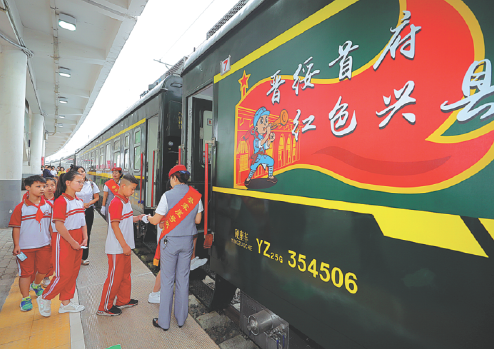Red tourism brings riches to villagers
Updated: 2022-07-01

A group of students board the Taiyuan-Caijiaya train to visit the famed Red tour destination in Xingxian county. [Photo/China Daily]
People of Caijiaya in Xingxian county of Shanxi province take advantage of new revenue streams generated by visitors
Wen Shouhui, an 89-year-old in the village of Caijiaya in the western Shanxi county of Xingxian, likes to sit at his doorstep every morning in midsummer, enjoying the cool morning weather, chatting with neighbors and watching the tourists arrive.
He said at her age, the best thing to do is to enjoy his last lease of life, freed from any worldly worries.
He said what makes a worry-free life possible is the improved welfare of every resident in the village.
"The pension for every senior like me is more than 1,000 yuan ($150) a month," Wen said. "And most of the cost of healthcare is covered by the government."
Wen said he also enjoys a government-granted subsidy for military veterans. He added that there are still quite a few veterans who used to serve in the armed forces led by the Communist Party of China in the 1940s.
In many ways, Caijiaya appears to be an ordinary village near the Weifen River, a branch of the Yellow River, in the heart of the Lyuliang Mountains.
However, it is historically extraordinary. More than 80 years ago, it was part of the Jinsui Revolutionary Base, home to the headquarters of the 120th Division of the Eighth Route Army led by famed Chinese general He Long (1896-1969). The army division was stationed there to protect Yan'an in neighboring Shaanxi province, the cradle of the Chinese Communist revolution during China's War of Resistance Against Japanese Aggression (1931-45) and China's War of Liberation (1946-49).
Today, the Jinsui Revolutionary Memorial Hall in Caijiaya is a silent witness to the past. Red tourism, which focuses on tours exploring the history of the CPC before the founding of the People's Republic of China in 1949, has grown tremendously during the past few years.
Caijiaya's popularity began to increase in the early 2010s with the boom of Red tourism. It made headlines in 2017 when some of the nation's leaders visited the village, hoping it to become one of important national bases for patriotic education.
The opening of a passenger railway route, which links Caijiaya and the provincial capital of Taiyuan, has further increased its appeal to tourists.
After renovating a former freight line, the Taiyuan Bureau of China Railway Group launched a passenger route between Taiyuan and Caijiaya on June 21, 2018, which, in turn, established the first passenger train service in Xingxian county. The whole trip takes about four hours.
Before that, traveling from the Lyuliang Mountains to the rest of Shanxi province was no easy feat.
"It took more than seven hours from Xingxian to Taiyuan by bus. And the ride on zigzagging and bumpy mountain roads was especially uncomfortable for carsick passengers," said Zhang Jinmei, a native of Caijiaya who now lives in Taiyuan.
Zhang is a frequent traveler between Taiyuan and Caijiaya as her parents now live in Caijiaya.
"Family reunions are highly valued in our culture," Zhang said. "So I like to visit my parents as frequently as possible."
She added that her husband's parents live in the county of Loufan, another destination on the railway line.
"I just feel this train service is tailored to my family, because there is much demand for us to travel between Taiyuan, Loufan and Caijiaya," Zhang said.
Executives of the Taiyuan Bureau of China Railway said the passenger train service aims to help revitalize the economy in regions the route passes through by offering travel for local people and bringing in tourists.
With tourists flocking to the Red tourism destination of Caijiaya, local residents have opportunities to improve their livelihoods with new sources of revenue.
Ren Jinfeng, 59, is a resident who works as a street cleaner near the Jinsui Revolutionary Memorial Hall. She has worked at this job for eight years and has witnessed great changes in the village since it became a destination for Red tourism a decade ago.
"Most of our fellow villagers have benefited from the Red tourism industry," Ren said. "Life can be improved if you are willing to work hard."
Ren said that street cleaning is not a highly paid job, but "it ensures a stable source of revenue for me". She added that the income has helped to support her three children through their education. "I'm proud that all my children have graduated from universities and found jobs."
Bai Xingping, a local resident, runs a supermarket near the railway station. "I opened a store here nearly 30 years ago, mainly serving locals in the beginning," Bai said. He added that it had been only a small, self-run business for more than two decades.
"With the rapid growth in tourists after the opening of the train station, my business has grown into a larger supermarket," Bai said.
In addition to locals, Bai said his customers include tourists and construction workers.
"We've seen an increasing number of construction workers in Caijiaya," Bai said. "They are here to build various tourism and transport facilities."
Bai Yang, deputy chief of the village, said the Taiyuan-Caijiaya train service has brought in more than 20,000 tourists annually over the past four years. "There are even greater numbers of tourists coming here by car, by bus or even by plane," Bai Yang said.
Wen Baoquan, Party secretary of the village, said the villagers have seen their incomes increase steadily over the past few years, thanks to the development of tourism and other industries.
"Per capita disposable income in Caijiaya reached 8,000 yuan in 2021, compared with 6,200 yuan in 2017," Wen Baoquan said.
Guo Yanjie contributed to this story.



